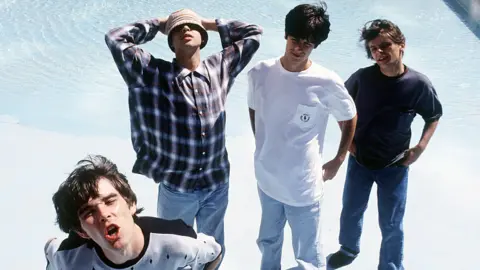 Getty Images
Getty ImagesWho are The Stone Roses?
With singles such as This Is the One, I Am the Resurrection and Fools Gold, The Stone Roses provided some of the biggest soundtracks of the Madchester music scene in the late 1980s and early 1990s.
The movement saw an explosion of a musical and cultural scene in the North West city, where a blend of indie rock with elements of acid house, psychedelia, and 1960s pop rose in popularity.
Matt Mead, who has published a book about the band, says: “The Stone Roses were the biggest band at that time. They were as big, if not bigger, than U2, who were massive.”
“Their musicianship was second to none. I mean, you just had four members, but there was some sort of magic that happened when they were on stage.”
The band, which formed in Manchester in 1985, originally featured singer Ian Brown, guitarist John Squire, bassist Mani and drummer Reni.
Along with the music, they had a distinctive style, leading teenagers to adopt baggy clothing, mop haircuts and bucket hats. Manchester United even launched a kit collection in 2024 inspired by the band.
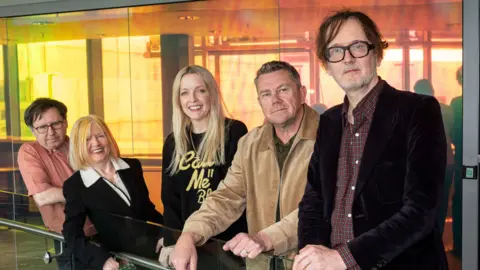
Where is Spike Island?
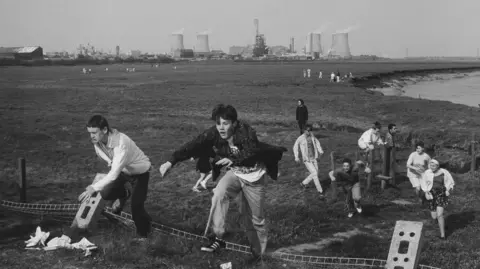 Getty Images
Getty ImagesCreated after the 1833 extension of the Sankey Canal in Widnes, Cheshire, the island was the centre of Britain’s chemical industry during the Industrial Revolution.
Factories and railways dominated the area until the industry went into decline in the 20th Century.
As part of their series of gigs, The Stone Roses held a concert at the site on a sunny day on 27 May 1990.
The area has now become a haven for wildlife with paths for walkers and cyclists.
What happened at the concert?
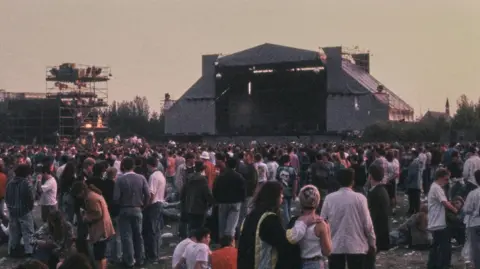 Getty Images
Getty ImagesOfficial figures suggest about 28,000 people attended the concert but Mead reckons that goes up to about 30,000 if you include gate-crashers.
Dave Haslam performed a DJ set before The Stone Roses’ performance and recalls how the band’s management booked the wrong DJ acts – getting Frankie Bones instead of Frankie Knuckles.
He says it was “evidence of the endearing amateurism around the gig”.
“My generation were not really into open air festivals. Glastonbury wasn’t anywhere like it is as big now.
“We liked rave venues or basement live music. We liked sweaty little venues clubs in the middle of town.”
 Getty Images
Getty ImagesThere have been mixed reviews of the concert with Pulp guitarist Mark Webber telling BBC 6 Music describing the show as “a slight anticlimax”.
“There was a lot of anticipation but it didn’t sound very good, it was very windy and the vibe wasn’t there.”
Haslam adds: “I don’t think anyone appreciated that you need to a lot of amplification to reach the back of the crowd, because all the sound just gets lost in the atmosphere.”
Mead, who is helping on a documentary project about the concert, says recently-found footage reveals “key moments when the band play I Wanna Be Adored and you see the crowd, it’s electric”.
“It’s like nothing else – wall-to-wall bouncing from the front to the back.”
He says there was also “blissed-out dancing” during Fools Gold and “everyone’s arms in the air” for I Am the Resurrection.
Haslam also remembers fans filing out of the gig in “very, very high spirits”.
“Whatever the problems with the sound and waiting around and all of that, I think for those young people, they knew they’d had a day out to remember.”
Why has the concert become a cultural moment?
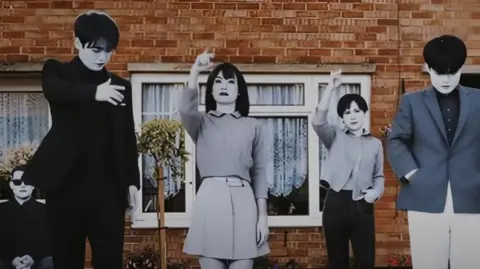 Rough Trade Records
Rough Trade RecordsUntil a full recording came to light in 2024, it was thought the concert had not been captured on film, making it the subject of much mystique for those who weren’t there.
But even with the new find, Haslam believes the gig was significant because The Stone Roses “didn’t play that often” and it felt like “a life-changing moment”.
“It was an opportunity to see this band that had somehow seemed to be the most significant band of the era.
“It was the culmination of two or three years when a certain look and a sound that was a kind of cross between funky indie and rave really animated a new generation.”
He says the Spike Island concert was part of a series of gigs that “took The Stone Roses from being a big local band and a kind of Manchester secret to being internationally renowned”.
Crews travelled from France and Germany for the event while fans came from across the country.
Haslam says “there wasn’t really anything similar afterwards” for the band due to time it took the band to release a second album.
“That took far too long – four or five years – so a lot of the momentum went out of the Roses at that point and by the time they came back, that part of the world had all moved on to Oasis.
He said Spike Island “was the only moment where you had The Stone Roses absolutely at their peak, playing music that had been quite underground but had been becoming accepted by the mainstream – that mix of euphoric rave vibe with rock music”.















